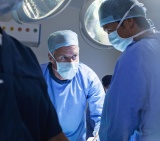Title: PO versus IV antibiotics for the Treatment of Infected Nonunion of Fractures After Fixation
Funded by Department of Defense (W81XWH-22-1-0635), PI: Obremskey, Vanderbilt University Medical Center
Fractures of bones are a common injury in civilians and in modern warfare. Most fractures are fixed with internal fixation to hold the fracture stable while the bone heals. Approximately 5-20% of severe fractures may not heal and a significant cause of not healing is a deep infection. Research studies have not identified the best way to treat these infections associated with fractures that have not healed. The fractures will need repeated internal fixation and treatment with either antibiotics by mouth or via an IV. With this study, we hope to determine the best method to give antibiotics to patients with an infection after fixation of a fracture and the fracture needs revision fixation. Patients will be randomized (by a flip of the coin) to receive antibiotics by mouth or antibiotics in an IV. This research will hopefully decrease the complications and improved compliance of antibiotic administration. If antibiotic treatment is simplified by giving antibiotics by mouth with no worse outcomes, this will decrease complications that a civilian or soldier that has an infection complication will have. If this is successful it could alter the way all infections after fixation of fractures that have not healed are treated and decrease the costs of treatment.
Title: Accelerating Recovery Following a Lower-Extremity Fracture through Speed HIIT
Funded by Department of Defense (W81XWH-21-1-0273), PI: Noehren, University of Kentucky, Site PI: Archer, Vanderbilt University Medical Center
Lower extremity traumatic fractures are one of the largest medical burdens in the United States military, costing almost $2 billion annually and resulting in the highest percentage of days on limited duty. These injuries result in long-term limitations in physical function which directly contribute to reduced Department of Defense (DoD) operational readiness. Consequently, there is an unmet need to optimize post-operative rehabilitation strategies, in order to more effectively and efficiently restore the injured service members physical function. To address this unmet clinical need, this pilot clinical trial will assess a novel high intensity interval training (HIIT) neurorehabilitative speed walking program during the early period of recovery to improve return to work, functional abilities, and psychosocial recovery following a long bone fracture. Results will be a clinically deployable treatment for patients after lower extremity trauma to maximize recovery and their physical ability to reintegrate to operational readiness.
Funded by Department of Defense (W81XWH-16-2-0060), PI: Archer, Vanderbilt University Medical Center
Each year, millions survive traumatic injuries and as a result are faced with life altering outcomes. Over 2.5 million individuals are hospitalized each year due to traumatic injuries. In addition, an analysis of over 16 million traumatic injury discharges from US hospitals between 2000 and 2011 revealed that majority were due to extremity fractures. The financial burden on the US health care system due to trauma is substantial accounting for over $55 billion in lifetime direct and indirect costs for civilians. Physical and psychological impairments resulting from traumatic injuries are often significant and impact employment and functional independence for the 40 to 50 years of remaining life.
This multi-center randomized controlled trial is a collaboration between Vanderbilt University Medical Center and the Major Extremity Trauma Rehabilitation Research Consortium to determine the efficacy of a psychologically informed rehabilitation program in service members and civilians following traumatic lower-extremity injury. This study aims to improve physical function outcomes and help patients return to normal activities. (https://clinicaltrials.gov/ct2/show/NCT03335657)
Title: MORE Resiliency in the Rehabilitation of Active Duty Service Members
Funded by Department of Defense (W81XWH-16-2-0061), PI: Archer, Vanderbilt University Medical Center
Resiliency (i.e., the process of negotiating, managing, and adapting to a traumatic event) is an important concept that has received little attention in both the civilian and military orthopaedic trauma literature. Individuals with high resiliency are more likely to positively adapt when recovering from trauma. Therefore, it is critical that rehabilitation specialists identify individuals with low resiliency in order to improve outcomes after lower-extremity injury.
This prospective cohort study aims to develop and test a resiliency instrument that is relevant to active duty Service Members. This instrument has the potential to help physical therapists and other health care providers identify Service Members who could benefit from additional skills associated with resiliency (social skills, problem-solving, relaxation, positive coping).
http://news.vumc.org/2016/10/20/effort-aims-to-measure-resiliency-in-in…
Funded by Department Of Defense (W81XWH-18-1-0810), PI: Obremskey, Vanderbilt University Medical Center
Ankle fractures are common in the military's adult population and there is no consensus regarding the optimal time to weight bear after surgery. This two group randomized controlled trial (RCT) is comparing the effect of early and delayed weight bearing in patients with operatively treated ankle fractures. A smaller pilot RCT will be conducted alongside the larger definitive trial to determine the impact of early and delayed weight bearing in patients surgically treated for unicondylar plateau fractures. Patients will be followed for 12 months following definitive fracture fixation. The study will be conducted in collaboration with the Major Extremity Trauma and Rehabilitation Consortium (METRC) and its Coordinating Center at Johns Hopkins. Participants will be recruited from up to 16 civilian Level I trauma centers across the United States. (https://clinicaltrials.gov/ct2/show/NCT04028414)




